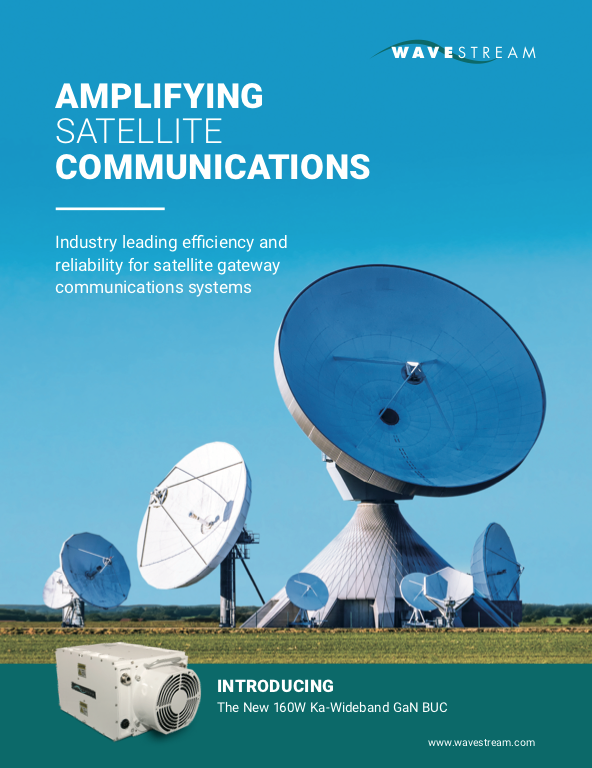Antennas are useless until coupled with the appropriate radio frequency (RF) equipment, such as a modem, block up converter (BUC), low noise block (LNB), etcetera.
Naturally, baseband equipment is a requirement. Of course, all these components need power, and a way to easily point the antenna is required.

Bringing all these disparate components together to provide the end-user with an integrated, practical, rugged and easy-to-use package has been the purview of systems integrators. Virtually all modem, antenna and radio frequency terminal manufacturers have extremely close working relationships with their integrator partners. For decades, these vendors have formed a symbiotic ecosystem which is a crucial part of the satellite industry.
The job of the systems integrator is not an easy one. Although designing and ordering custom-made components is often a possibility, quite frequently, the integrator must use off-the-shelf components and work within the physical and operational parameters of the modules.
The unique characteristics of the components greatly reduce the flexibility the integrator has to minimize the size, weight and power (SWaP) of the terminal. These problems are greatly magnified when integrating with flat panel, electronically steerable antennas (ESAs).
One highly valued characteristic of ESAs are their inherent SWaP. If the supporting components in the integrated terminal are not designed specifically to integrate with flat panel antennas, the SWaP attributes of the solution will be greatly undermined.
Another growing trend affecting flat panel integration in the satellite industry is the proliferation of waveforms and end-user needs for them to support. The simplest solution to supporting multiple waveforms is to utilize multiple modems. Employing multiple modems is hardly an elegant solution, and of course, is not conducive to SWaP.
The proliferation of waveforms is driven by a number of factors but fundamentally based on enhancements of satellite technologies. The move from bent pipe, geosynchronous satellites to High Throughput Satellite (HTS) architectures drove an upsurge of new waveforms. Medium Earth Orbit (MEO) satellites is driving another trend.
One argument regarding the genesis of such a plethora of waveforms is the lack of accepted industry standards and satellite modem vendors protecting their own proprietary RF signals. Although there is some truth to the argument, emerging satellite technologies do necessitate changes to waveforms.
To meet the needs of the satellite end-user, both the convenience and SWaP of flat panel antennas and multiple waveforms in a single, compact modem are required. The preeminent solution to the multi-waveform problem is the development of a Software Defined Radio (SDR).
SDRs have been in the market for a number of years, however, not all SDRs can accommodate all waveforms. With a thorough understanding of hardware and firmware design of a modem, one realizes there are underlying system elements which are waveform dependent.
For example, automatic gain control (AGC) algorithms can be vastly different on single channel per carrier (SCPC) modems compared to AGCs on time division multiple access (TDMA) modems. The waveform timing mechanism often determines which clocks within the hardware are free running versus slaved.
The tradeoff between the physical dimensions of the analog portion of the SDR modem versus the range of modulation orders supported must be carefully considered. All of these challenges can be overcome; however, it does lead to the integration work of a waveform on an SDR modem to be more complex than is often imagined.
The key to success in designing components for the next-generation flat panel antennas is flexibility. Various flat panel antenna manufacturers will have different architectures for their integrated antenna control units (ACUs) and other components essential to the antenna design.
To meet the SWaP requirements, flat panel antenna manufacturers and terminal integrators cannot be plagued by problems such as cable bend radius to realize a design. Therefore, the outmoded paradigm of simply integrating off-the-shelf components where the IF, Ethernet, power and other interfaces are predetermined will no longer suffice. It is imperative a new physical architecture for modems be adopted. This means incorporating an architecture which allows for freedom of design.
Such an architecture would mean that the analog section and the digital section of the modem are no longer rigidly coupled, but rather they use standardized interfaces and have internal loopback self-checks. This allows an antenna manufacturer or an integrator to design their own carrier board complete with all the components necessary to deliver a comprehensive solution.
By decoupling the analog and digital portions of an SDR and allowing flat panel antenna manufacturers and integrators the flexibility to directly integrate the components on the control board instead of using IFL and Ethernet cable, the promise of a truly integrated system can be achieved.
In addition, this approach serves as a bridge to the next steppingstone in terminal design, which is the migration toward digital IF. With digital IF, the interface to the SDR is no longer L-band, but, rather digitized RF known as in-phase quadrature, more commonly referred to as I/Q.
The revolution in antenna design — which is being driven by radical changes in satellite technologies and multi-orbit topologies — is, likewise, driving a revolution in modem and RF transmission equipment. It is vital to the satellite industry that the manufacturers of all components — whether antenna, SDR or transmission — be in lockstep as technology marches on to ensure the best solutions reach the end-users.
www.idirectgov.com

Karl Fuchs is the Senior Vice President of Technology at iDirectGov, a U.S. corporation that is a trusted partner of the U.S. government and has been for more than 17 years. Fuchs has more than 20 years of experience in the areas of technology and the federal government and is a Senior Contributor to MilsatMagazine.
Fuchs leads iDirectGov’s team of federal systems engineers and serves as chief architect for new product integration and specialized technology, including transmission security (TRANSEC), Communication Signal Interference Removal (CSIR™) and Open Antenna Modem Interface Protocol (OpenAMIP).
All Defense-grade products sold by iDirect Government are designed, developed, assembled, programmed and verified within the United States. All of the company’s employees are U.S. citizens, with a third being U.S. military veterans and more than 60 percent holding U.S security clearances.
Contact Karl Fuchs at kfuchs@idirectgov.com


